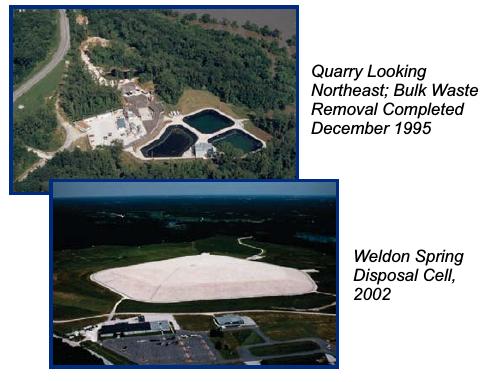The EEOICPA was passed in 2000. It provides compensation to workers who became ill as a result of their employment manufacturing nuclear weapons in the USA, as well as their spouses, children, and grandchildren. Weldon Spring Quarry EEOICPA coverage is available for qualified former Workers and their families.
Are you eligible for compensation? If you or a family member worked at this or another DOE facility and became ill, you may be entitled to compensation of up to $400K plus medical benefits. Call EEOICPA Counsel Hugh Stephens at 1-855-548-4494 or fill out our free claim evaluation, We can help even if you’ve already filed, even if your claim was denied!
Here, we have compiled publicly available information and documentation about the facilities covered by the Act to clarify how their activities relate to the Energy Employees Occupational Illness Compensation Program Act.
Weldon Spring Quarry
State: Missouri
Location: Weldon Spring
Time Period: DOE 1958–1966; 1967–2002 (remediation)
Facility Type: Department of Energy
Facility Description: In 1958, the U.S. Atomic Energy Commission (AEC) acquired title from the U.S. Department of the Army (Army) to an inactive quarry that had been on the Weldon Springs Ordnance Works land. The quarry was used by the AEC as a dumping ground for chemical and radiological waste products, including the demolished Destrehan Street Plant in St. Louis.
Surface decontamination of the quarry was completed in October 2002.
Contractors: Mallinckrodt Chemical Company (1958–1966); National Lead of Ohio (1966–1981); Bechtel National, Inc. (1981-1985); MK-Ferguson Company and Jacobs Engineering Group (1986–2002)
Listing:
Weldon Spring Quarry is listed as a Department of Energy (DOE) site under the EEOICPA.
*Weldon Spring, Missouri, Site History:
The Weldon Spring, Missouri, Site has transformed from a site once used to manufacture explosives and process uranium-ore concentrates to a publicly accessible area for recreation and education.
Early Years
The U.S. Army acquired 17,232 acres in St. Charles County near Weldon Spring, Missouri, in 1941 as part of the World War II defense effort. From 1941 to 1945, the U.S. Army produced explosives at the Weldon Spring Ordnance Works. After the war, the government transferred owner- ship of some of the land to the State of Missouri, which used it to create the August A. Busch Memorial Conservation August A. Busch Memorial C Area. Another portion went to the University of Missouri, which used it for agricultural purposes. Except for several small parcels transferred to St. Charles County and the Francis Howell School District, the Army retained the remainder for use as a training area. The Weldon Spring site transferred to the former U.S. Department of Energy (DOE) Long-Term Surveillance and Maintenance Program on October 1, 2002, and to the DOE Office of Legacy Management (LM) in December 2003. In 1956, 217 acres of the former ordnance works property was transferred to the U.S. Atomic Energy Commission (AEC) for construction of the Weldon Spring Uranium Feed Materials Plant, later called the Weldon Spring Chemical Plant. The plant consisted of about 44 buildings, four settling basins totaling 25 acres called raffinate pits, two ponds, and two former dump areas.
The Army used a Quarry 4 miles south of the Chemical Plant for disposal of trinitrotoluene (TNT) residues. In 1958, AEC acquired title to the Quarry and used it to dispose of uranium- and radium-contaminated building rubble and soils from the demolition of auranium ore processing facility inSt. Louis, Missouri. A small amount of thorium residue was also disposed of in the Quarry. In 1967, AEC closed the plant and the Army reacquired it. The Army partially decontaminated several buildings, dismantled some of the equipment, and began converting the facilities to produce an herbicide known as Agent Orange for use in the Vietnam War. In 1969, reduced requirements for the herbicide and escalating cleanup costs resulted in the cancellation of the project. No herbicides were delivered or produced at Weldon Spring.
*Source


















